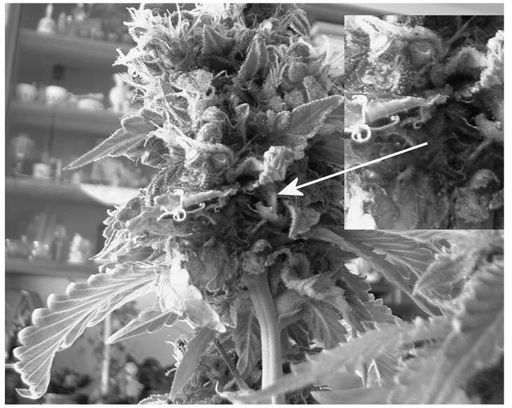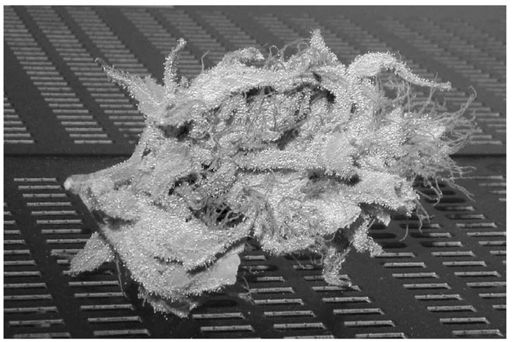The Cannabis Breeder's Bible (14 page)
Read The Cannabis Breeder's Bible Online
Authors: Greg Green


Ethrel
Ethrel contains ethlephon and is used to promote yields.
Formula 1
Formula 1 contains a broad range of hormones and is used to promote plant growth and also helps nitrogen-deficiency-related stress.
Power Bloom
PowerBloom also contains a broad range of hormones and is used to control plant height and internode lengths, and reduce branch growth. It also promotes flowering.
SensaSoak
SensaSoak is a germination solution that is used to encourage the production of females.
Superthrive
Superthrive contains the vitamin B1 (thiamine) and is used to help prevent transplant shock. It also promotes good growth and plant vigor. Superthrive is popular with cloning techniques.
Wood’s Rooting Compound
Wood’s Rooting Compound contains indole-3-butyric acid (IBA), 1-napthalene acetic acid (NAA) and is used to promote root growth in cuttings.
Remember when using hormones that you are directly affecting plant growth. Plants already produce their own hormones and sometimes adding hormones can have an adverse effect on your plants. Hormone treatment is mostly experimentation. The only hormone treatment that comes highly recommended is Superthrive (B1-thiamine), which is clinically proven to help cuttings root and plants survive transplant shock.
TROPISM
It is difficult to talk about hormones without talking a little about tropism. Tropism is the turning of an organism or part of an organism in a particular direction by growth, bending, or locomotion, in response to some special external stimulus. Hormones also regulate many tropisms. As a cannabis breeder there are three tropisms you should know about.
Geotropism
Geotropism is the sense of the direction of gravity. Seedlings use it to know which way they should grow after germination.
Gravitropism
Gravitropism is very similar to geotropism. Most cannabis branches curve upward. Auxin development causes the branch to curve upward due to cell expansion. The choice of where auxins develop is strategic for gravitropism to occur. Gravitropism causes roots to grow down.
Phototropism
Phototropism is a growth response toward the light caused by auxin stimulation of cells not exposed to light. An uneven distribution of auxins in the plant’s stem causes phototropism. Auxins gather on the side of the stem that does not receive the most light. These auxins cause the stem to bend toward the light. When the light is received the auxins are eradicated and the bending process stops.
The strain LSD from BOG shows how breeders can create lots of small crystal plenty nuggets on one plant. The grower, BOG, was featured in The Cannabis Grow Bible before he became a breeder. If you have seen his plants in our previous book then you can understand why the market started demanding seeds from him.

6
THE CODE OF LIFE
THE BASICS OF CHROMOSOMES
Chromosomes consist of a single molecule of DNA and are associated with histones. Histones are a group of simple basic water-soluble proteins that occur and are associated with DNA in the cell nuclei of eukaryotes. There are some non-histones present there too. They actually work on sorting out which parts of the DNA will be converted into RNA.
DNA are nucleic acids in which the sugar component is deoxyribose. It is a self-replicating material present in nearly all living organisms, especially in the case of chromosomes, as the carrier of genetic information and the determiner of protein synthesis. DNA stands for DeoxyriboNucleicAcid and RNA stands for RiboNucleicAcid.
Before we discuss more about chromosomes and what they are, let’s look at the process of mitosis.
MITOSIS
Mitosis is the process of division by which a cell nucleus gives rise to two daughter nuclei identical to the parent in number and size of chromosomes.
Chromosome:
A threadlike structure of nucleic acids and protein which carries a set of linked genes and occurs singly in prokaryotes and in characteristic numbers, usually paired, in the cell nuclei of higher organisms.
In mitosis a eukaryotic cell divides into two. Each daughter or progeny cell will get:
1. A complete set of genes.
2. Some mitochondria and chloroplasts.
3. Some ribosomes, some of the endoplasmic reticulum, and maybe some other organelles.
Mitosis is simply genetic code reproduction within a cell. This is all you really need to know about mitosis for breeding purposes. The actual stages of mitosis are the prophase, prometaphase, metaphase, anaphase and telophase.
The interesting point about mitosis and genetic code reproduction within a cell is that some cells carry identical gene pairs to ensure that mitosis works and that the genetic code for a trait actually gets through to its destination. There are two main types of cells with regard to the reproduction of chromosomes that we need to know about for the time being: haploid cells and diploid cells.
Haploid cells are sometimes called monoploid cells. It means that the cell only has a single set of chromosomes. The notation symbol is - (n). When the cell divides it only reproduces one version of the chromosome at a time.
Diploid cells have two of each kind of chromosome except for the sex chromosomes. The notation is - (2n). When the cell divides it reproduces one version of each chromosome at a time but the resulting numbers are higher than a haploid cell.
Chromosomes are too small to be seen without expensive equipment. Before mitosis occurs each cell prepares itself for cell division. The duplicated chromosomes are called dyads and these can be seen with less expensive microscope equipment because the chromosome stretches itself out.
All information transmitted from the parent plant to the offspring generation must be contained in the pollen of the staminate parent and the ovule of the pistillate parent.
Fertilization unites these two sets of genetic information. A seed forms and a new generation begins. As we have seen, both pollen and ovules are known as
gametes,
and the transmitted units determining the expression of a character are known as
genes.
Individual plants have two identical sets of genes (2n) in every cell except the gametes, which through reduction and division have only one set of genes. Upon fertilization one set from each parent combines to form a seed (2n).
In cannabis the haploid number of chromosomes is 10 and the diploid is 20. The gametes are haploid
.
POLYPLOIDY
There is an unnatural condition in cannabis called the polyploid state. This happens when a cell contains more than two homologous sets of chromosomes and may breed the condition through to other cannabis plants. It is possible that such a condition arose from mutations and that those mutant plants drifted in and out of different populations in the wild, but the problem is that the trait is not usually stable or sustainable through seed.
Polyploids have been noticed in the wild on rare occasions but are more than likely either the result of man-made interference with cannabis plants or an ancestral mutation that passed down the lines. Either way there is not enough information currently available on the polyploid status of the cannabis plant to know much about it. Some researchers, such as H.E Warmke, have suggested that polyploid cannabis plants have higher potency levels than normal. This does not appear to be case. Although there are known linkages in cannabis genes there is nothing to suggest that the polyploid condition is somehow linked to potency. Nor is there any evidence to suggest that the polyploid condition will affect potency. It is extremely hard to continue the polyploid trait in offspring because the parent plants usually end up sterile in the process. You need to have large selections in order to experiment with this condition.
There are many products on the market that will mutate cells. Colchicine is one such substance that actually promotes the polyploid condition. However colchicine is also a mutagen and mutations are not under the grower’s control. It is more than probable that the potent polyploid condition was the result of separate mutations in Warmke’s experiments. In the future we hope to see more research in this area.
7
EVOLUTION AND MUTATIONS
GREGOR MENDEL AND EVOLUTION
The theory of evolution is just that—a theory. Although the theory itself, proposed by Darwin, contains much merit, and is very much applicable to cannabis species development, it is still very much a recent discovery and much of it is still an incomplete work. The reader is asked not to take evolution theory at face value but to consider the anomalies associated with evolution theory and maybe do a little research for him or herself before subscribing entirely to this area of scientific thought.
While we can look at principles like Hardy-Weinberg’s Equilibrium and see set rules and know how and when those rules can be broken, the theory of evolution still has some problems that we have yet to clearly observe or discover answers to.
One of the most important elements to the theory of evolution is mutations. Since man, plants, fly and worm have all evolved from the same source, why are there no links found in fossils which prove this is so? It could be that we have not found such links yet, but as science dictates we clearly have no evidence to support the half-human/half-ape concept. There are no fossils of any such creature in any science lab or museum. All we have at our disposal is a theory coupled with all these different life-forms that we actually say are linked through evolution.
Some Problems to Consider
1. Gregor Mendel himself showed that the theory of evolution needs to be looked at more closely.
2. No mutations have ever been observed which are beneficial to an organism.
3. Mutations are not really controllable. They are random, without focus and can be extremely damaging to the organism and its offspring.
These are important points for the reader to consider if he or she believes the theory of evolution is a fact. It is not a fact, it is just an extremely good theory. The theory of organic evolution is unfounded in many aspects. Organic evolution has never been observed. Let’s start at the beginning and work our way through this so that we get a better understanding of mutations.
Spontaneous generation of life from dead matter or nonliving matter has never been seen nor has it been performed. We cannot bring the dead back to life, nor do mountains full of every material known to man under every condition known to man produce from themselves living matter. Life appears to only come from other living things. A rock does not mutate into a living creature and neither does a jar full of dead animal tissue. Biogenetics is the actual study of this topic and is taught in universities.
The most famous experiment attempt to prove whether or not life could be created from chemicals was carried out in 1953 by Stanley L. Miller and Harold C. Urey, working at the University of Chicago. The experiment has since been known as the Miller/Urey experiment. Miller obtained molecules which were thought to be the major parts of the early Earth’s atmosphere and put them into a closed system. The experiment produce amino acids and these are the basics of DNA. However there are still many questions that need to be asked and the Miller/Urey experiment is still a far cry from developing life from chemicals in a test tube. They did not create DNA nor has anyone managed to do so in the lab using these environmental experiments. At the moment we are still in the realm of biogenetics whereby life is producible only from other living organisms and not dead matter. However we do know that the possibility of DNA developing from amino acids MAY occur and this is how we currently explain the model of life evolving from dead matter, although we must remember that this has never been proven or observed in the lab.